Boosting developer success on Google Play

Posted by Sameer Samat, VP, Product Management Helping developers build sustainable businesses is a core part of Google Play’s mission. We work with partners every day to understand the challenges they face and help them bring their innovative ideas to life. Getting a new app off the ground and into orbit is not easy! To aid their quest for growth we provide a broad range of support, from powerful marketing tools and actionable data in the Play Console , education via Play Academy , "> best practices and thought leadership resources, programs such as the Indie Games Festival , Indie Corner , and accelerator programs around the world. We’re always looking for new ways to give them an added boost. Starting on July 1, 2021 we are reducing the service fee Google Play receives when a developer sells digital goods or services to 15% for the first $1M (USD) of revenue every developer earns each year. With this change, 99% of developers globally that sell digital goods and servic...






